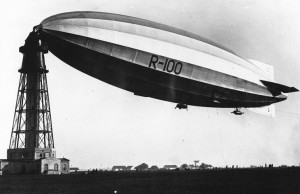Nine years prior to the 1937 Hindenburg disaster, Popular Science ran a breathless article about the advent of commercial dirigibles, as England and Germany raced to be the first to launch a successful transatlantic flight with passengers. In 1928, the balloons were planned to hold roughly 100 ticket buyers and the price from New York to London was going to be $400. That transatlantic trip was scheduled to take 38 hours to complete. Pictured is the English airship R-100, which the article thought was the favorite in the transatlantic race. It had beds, baths with showers, saloons, an area on deck for dancing and refreshment tables. The only note of caution about this potentially dangerous new mode of transportation–quickly dismissed–comes late in the article. An excerpt:
“To be sure, this history must consider the disaster of the American-built and operated Navy dirigible Shenandoah, broken in two by a storm over Ohio in 1925 and destroyed with the loss of fourteen men. And the fate before that of the German-built, French-operated military dirigible Diamude, lost in the storm over the Mediterranean. And that of the Italian-built, American-operated Roma, military dirigible, which, forced down by rudder trouble, struck a high tension cord and burned when the hydrogen in its gas bags exploded. There have been costly errors in construction and operation of the first great ships. But the builders have profited by all these mistakes. Each disaster has taught a new lesson.”
The German airship, the L7-127, which is given less attention in this piece, won the race with its first commercial passenger transatlantic flight on October 11, 1928. In November 1931, after the disaster of fellow British airship R-101, the R-100 was discontinued. It was flattened and sold for scrap.
Tags: Hindenburg

